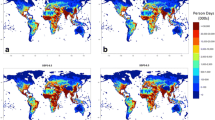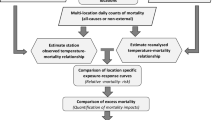Abstract
One challenge for statisticians and epidemiologists in projecting the future health risks of climate change is how to estimate exposure-response relationships when temperatures are higher than at present. Low dose extrapolation has been an area of rich study, resulting in well-defined methods and best practices. A primary difference between high dose and low dose extrapolation of exposure-response relationships is that low dose extrapolation is bounded at no exposure and no (or a baseline) response. With climate change altering weather variables and their variability beyond historical values, the highest future exposures in a region are projected to be higher than current experience. Modelers of the health risks of high temperatures are making assumptions about human responses associated with exposures outside the range of their data; these assumptions significantly affect the magnitude of projected future risks. Further, projections are affected by adaptation assumptions; we explore no adaptation (extrapolated response); individual (physiological) adaptation; and community adaptation. We present an example suggesting that linear models can make poor predictions of observations when no adaptation is assumed. Assumptions of the effects of weather above what has been observed needs to be more transparent in future studies. Statistical simulation studies could guide public health researchers in identifying best practices and reducing bias in projecting risks associated with extreme temperatures. Epidemiological studies should evaluate the extent and time required for adaptation, as well as the benefits of public health interventions.
Similar content being viewed by others
References
Anderson, B. G., and Bell, M. L. (2009), “Weather-Related Mortality: How Heat, Cold, and Heat Waves Affect Mortality in the United States,” Epidemiology, 20, 205–213.
Anderson, G. B., and Bell, M. L. (2011), “Heat Waves in the United States: Mortality Risk During Heat Waves and Effect Modification by Heat Wave Characteristics in 43 U.S. Communities,” Environmental Health Perspectives, 119, 210–218.
Baccini, M., Biggeri, A., Accetta, G., Kosatsky, T., Katsouyanni, K., Analitis, A. et al. (2008), “Heat Effects on Mortality in 15 European Cities,” Epidemiology, 19, 711–719.
Baccini, M., Kosatsky, T., Analitis, A., Anderson, H. R., D’Ovidio, M., Menne, B. et al. (2010), “Impact of Heat on Mortality in 15 European Cities: Attributable Deaths Under Different Weather Scenarios,” Journal of Epidemiology and Community Health. doi:10.1136/jech.2008.085639.
Ballester, J., Robine, J. M., Herrmann, F. R., and Rodo, X. (2011), “Long-Term Projections and Acclimatization Scenarios of Temperature-Related Mortality in Europe,” Nature Communications, 2, 358.
Carson, C., Hajat, S., Armstrong, A., and Wilkinson, P. (2006), “Declining Vulnerability to Temperature-Related Mortality in London Over the 20th Century,” American Journal of Epidemiology, 164, 77–84.
Cheng, C. S., Campbell, M., Li, Q., Li, G., Auld, H., Day, N., et al. (2009), “Differential and Combined Impacts of Extreme Temperatures and Air Pollution on Human Mortality in South-Central Canada. Part II: Future Estimates,” Air Quality and Atmospheric Health, 1:223–235.
Confalonieri, U., Menne, B., Akhtar, R. et al. (2007), Climate Change 2007: Impacts, Adaptation and Vulnerability. Contribution of Working Group II to the Fourth Assessment Report of the Intergovernmental Panel of Climate Change, Cambridge: Cambridge University Press, pp. 41.
Conti, S., Meli, P., Minelli, G., Solimini, R., Toccaceli, V., Vichi, M. et al. (2005), “Epidemiologic Study of Mortality During the Summer 2003 Heat Wave in Italy,” Environmental Research, 98, 390–399.
Davis, R. E., Knappenberger, P. C., Michaels, P. J., and Novicoff, W. M. (2003), “Changing Heat-Related Mortality in the United States,” Environmental Health Perspectives, 111, 1712–1718.
Davis, R. E., Knappenberger, P. C., Michaels, P. J., and Novicoff, W. M. (2004), “Seasonality of Climate-Health Mortality Relationships in US Cities and Impacts of Climate Change,” Climate Research, 26, 61–76.
Doyon, B., Belanger, D., Gosselin, P. (2008), “The Potential Impact of Climate Change on Annual and Seasonal Mortality for Three Cities in Québec, Canada,” International Journal of Health Geographics, 7:23.
Gasparrini, A., and Armstrong, B. (2011), “The Impact of Heat Waves on Mortality,” Epidemiology, 22, 68–73.
Gosling, S. N., McGregor, G. R., and Lowe, J. A. (2009), “Climate Change and Heat-Related Mortality in Six Cities Part 2: Climate Model Evaluation and Projected Impacts From Changes in the Mean and Variability of Temperature With Climate Change,” International Journal of Biometeorology, 53, 31–51.
Hajat, S., Armstrong, B., Baccini, M., Biggeri, A., Bisanti, L., Russo, A. et al. (2006), “Impact of High Temperatures on Mortality: Is There an Added Heat Wave Effect?,” Epidemiology, 17, 632–638.
Havenith, G. (2005), “Temperature Regulation, Heat Balance, and Climatic Stress,” in Extreme Weather Events and Public Health Responses, eds. W. Kirch, R. Bertollini, and B. Menne, Berlin: Springer, pp. 69–80.
IPCC (2007), “Climate Change 2007: Synthesis Report. Contribution of Working Groups I, II and III to the Fourth Assessment Report of the Intergovernmental Panel on Climate Change” [Core Writing Team, Pachauri, R. K. and Reisinger, S. (eds)]. IPCC, Geneva, 104 pp.
Jackson, J. E., Yost, M. G., Karr, C., Fitzpatrick, C., Lamb, B. K., Chung, S. H., et al. (2010), “Public Health Impacts of Climate Change in Washington State: Projected Mortality Risks Due to Heat Events and Air Pollution,” Georgetown Climate Center. http://cses.washington.edu/db/pdf/wacciach10health653.pdf.
Knowlton, K., Lynn, B., Goldberg, R. A., Rosenzweig, C., Hogrefe, C., Rosenthal, J. K. et al. (2007), “Projecting Heat-Related Mortality Impacts Under a Changing Climate in the New York City Region,” American Journal of Public Health, 97, 2028–2034.
Kovats, R. S., and Hajat, S. (2008), “Heat Stress and Public Health: A Critical Review,” Annual Review of Public Health, 29, 41–55.
Le Tertre, A., Lefranc, A., Eilstein, D., Declercq, C., Medina, S., Blanchard, M. et al. (2006), “Impact of the 2003 Heatwave on All-Cause Mortality in 9 French Cities,” Epidemiology, 17, 75–79.
McMichael, A. J., Wilkinson, P., Kovats, R. S., Pattenden, S., Hajat, S., Armstrong, B. et al. (2008), “International Study of Temperature, Heat and Urban Mortality: The ‘ISOTHURM’ Project,” International Journal of Epidemiology, 37 (5), 1121–1131.
Muthers, S., Matzarakis, A., and Koch, E. (2010), “Climate Change and Mortality in Vienna—A Human Biometeorological Analysis Based on Regional Climate Modeling,” International Journal of Environmental Research and Public Health, 7, 2965–2977.
O’Neill, M. S., and Ebi, K. L. (2009), “Temperature Extremes and Health: Impacts of Climate Variability and Change in the United States,” Journal of Occupational and Environmental Medicine, 51, 13–25.
NOAA National Climatic Data Center, State of the Climate: Global Analysis for July 2011, published online August 2011, retrieved on August 27, 2011 from http://www.ncdc.noaa.gov/sotc/global/2011/7.
NOAA. NOAA: 2010 Tied For Warmest Year on Record, published 12 January 2011. http://www.noaanews.noaa.gov/stories2011/20110112_globalstats.html.
NOAA National Climatic Data Center, State of the Climate: Global Analysis for Annual 2010, published online December 2010, retrieved on August 27, 2011 from http://www.ncdc.noaa.gov/sotc/global/2010/13.
Parsons, K. C. (2003), Human Thermal Environments: The Effects of Hot, Moderate, and Cold Environments on Human Health, Comfort, and Performance, London: Taylor & Francis.
Peng, R. D., Bobb, J. F., Tebaldi, C., McDaniel, L. Bell, M. L., and Dominici, F. (2011), “Toward a Quantitative Estimate of Future Heat Wave Mortality Under Global Climate Change,” Environmental Health Perspectives, 119, 701–706.
Rocklöv, J., Ebi, K., and Forsberg, B. (2011), “Mortality Related to Temperature and Persistent Extreme Temperatures: A Study of Cause-Specific and Age-Stratified Mortality,” Occupational & Environmental Medicine, 68, 531–536.
Rocklöv, J., Forsberg, B., and Meister, K. (2009), “Winter Mortality Modifies the Heat-Mortality Association the Following Summer,” The European Respiratory Journal, 33 (2), 245–251.
Sherwood, S. C., and Huber, M. (2010), “An Adaptability Limit to Climate Change Due to Heat Stress,” Proceedings of the National Academy of Sciences , 107, 9952–9955.
Solomon, S. Intergovernmental Panel on Climate Change. Working Group I. (2007), Climate Change 2007: The Physical Science Basis: Contribution of Working Group I to the Fourth Assessment Report of the Intergovernmental Panel on Climate Change, Cambridge: Cambridge University Press.
Stafoggia, M., Forastiere, F., Michelozzi, P., and Perucci, C. A. (2009), “Summer Temperature-Related Mortality: Effect Modification by Previous Winter Mortality,” Epidemiology, 20 (4), 575–583.
Takahashi, K., Honda, Y., Emori, S. (2007), “Assessing Mortality Risk From Heat Stress Due to Global Warming,” Journal of Risk Research, 10:339–354.
Tol, R. S. J. (2008), “The Social Cost of Carbon: Trends, Outliers and Catastrophes. Economics: The Open-Access,” Open-Assessment E-Journal, 2, 2008–2025. Available: http://www.economics-ejournal.org/economics/journalarticles/2008-25.
Author information
Authors and Affiliations
Corresponding author
Rights and permissions
About this article
Cite this article
Rocklöv, J., Ebi, K.L. High Dose Extrapolation in Climate Change Projections of Heat-Related Mortality. JABES 17, 461–475 (2012). https://doi.org/10.1007/s13253-012-0104-z
Published:
Issue Date:
DOI: https://doi.org/10.1007/s13253-012-0104-z




